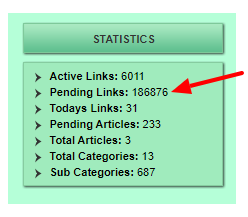To get a good directory listing that will help build up the links and reputation for your website, you need to identify a decent directory, submit your site correctly and follow up to check that your application has been approved.
Once you’ve narrowed down a list of suitable directories, the next step is to go through the submission process.
You should set aside about 15-20 minutes for each of them – this includes taking a detailed look through the site, deciding on the appropriate category to target, reviewing the listing options, signing up for an account (if required) and submitting your listing.
Listing Options
These are the typical listing options to be aware of when submitting to web directories:
- Free Listing: No payment required to add a listing to the directory (but approval time/success may be unknown though)
- Paid Listing: A one-time or annual fee is needed to submit a listing (which is normally approved within 48 hours)
- Featured/Sponsored Listing: These are types of paid listings to get prominent positions/placements
- Reciprocal Link: A lot of free listing directories require a reciprocal link, which means you have to link to them from your site to be approved
Although it may be tempting to choose the reciprocal link option, it is better to pay for a one-way link because “link exchanges” are easily detected and frowned upon by Google.
Directory Listing Fee/Prices
In order to be listed in a worthwhile directory, you will need to pay.
While it is theoretically possible to get a totally free link by submitting your website and waiting to be approved. In reality, you will need to pay in order to get listed in the majority of high quality directories, or your submission may be stuck in the pending approval status indefinitely.

Even in directories that offer free listings, you will probably have to pay for a “manual review“. So technically, the actual listing is free, but there will be a long list of sites awaiting approval. If you want to jump the queue and have the human editors approve your submission within a day or two, then you may have to pay $10 to $50 or even more.
Note: Buying and selling links to game search engine ranking systems is not allowed. Google may penalize your site if you’re found to be trading links to manipulate their algorithms. This is why some directories charge for the service of reviewing your listing rather than for the listing itself.
Other directories are more transparent and openly state that you need to pay a listing fee when making a submission. These paid listings usually cost about $10 to $50 as well and can go up to a few hundred dollars, depending on the site’s authority and whether it’s a one-time payment or a recurring subscription.
Alternatively, you could pay for a sponsored or featured listing which gives you better placement. Some SEOs claim that these links may not carry as much weight (in terms of SEO link value) because they are a paid advertisement rather than an editorial link. Others feel link positioning is more important.
Directory Submission Plan
Before rushing in blindly, it’s a good idea to draw up a plan to prevent being overwhelmed by all the little details to remember.
Here are some tips to make the process of directory site submissions more efficient:
- Start a spreadsheet to outline and document everything – it should serve as a control sheet to plan out the whole process and a place to record all the bits of information for each submission.
- Add the list of directories identified – note down their SEO metrics and any other data from your research. Categorize them, grade them, prioritize them and add to or prune them so that it’s an ongoing effort.
- Prepare the content about your site to be submitted – title, tagline, description, contact information, link details (ie anchor text, target), payment info and so on. It’s often a good idea to have a few versions of your site’s listing info (customized titles, varied descriptions, multiple anchor texts, link targeting strategy) crafted to suit each directory’s audience. For example, you may want to tweak your listing profile differently for industry vs local directories.
- Review the listing options and read the guidelines thoroughly for each directory thoroughly – copy any noteworthy points from the fine print to get a clear assessment of the best way to get listed. Make sure all the details are in your control document so that you have a central dashboard to find everything in the future.
- Analyze the merits of the available ways to submit your site – where will your site actually appear for a free listing, and in what order are listings displayed? If it is newest first, then you may be in deeper paginated pages in months to come. How will this change affect the value of the link? What are the exact terms of a featured listing or paid placement?
- Research the available categories to see which ones are suitable, the existing makeup of the listings, and how they’re ordered – if possible, examine the SEO metrics of the actual pages where you link will be published. Figure out if a placement on a deeper page of primary category is better or worse than the first page of a sub-category.
- Once you’ve made a decision, proceed to sign up, fill out the form, make the payment (if necessary) and hit submit – if you’ve done all the content beforehand, this part should be relatively quick.
- Make a note of specific terms, renewal payment dates and anything else you’d like to know more about the directory – if you contacted them to ask for something, remind yourself to follow up. If you want to know how the listings change, remind yourself to come back in a month or two.
It is important to make a note of all the little details so that you can remember what’s going on when you come back to check your directory links half a year later, or when annual listing fees are up for renewal.
Or, if someone else will be following up to build and maintain the links for your site in the future, they will need to know all the specifics of what you’ve done.
Summary
All of this certainly sounds like a lot of work that’s tedious and complicated.
Although it is possible to do-it-yourself (depending on how much web/SEO knowledge you have), it may not be practical or worth your time. For most people, the whole process is probably far too overwhelming.
There has to be an easier way to get a website submitted to web directories. Outsource it!
A good option is to engage an SEO company/freelancer who specializes in link building. They will include directory links as part of an overall package to create a range of backlinks so that your site has a balanced and more natural looking link profile.
Alternatively, you may have come across directory submission services offering to submit your site to hundreds of directories for a very cheap fee. A lot of webmasters get lured by the low cost way out. Skeptics will question how it’s possible.
If you’re wondering whether it’s worth trying them out, find out more in our analysis on why you need to be careful with directory submission solutions.
This article is part of WebsitePromote’s Guide to using Web Directories for SEO & Website Promotion.
- PART 1: Are Web Directories still Effective in the 2020’s
- PART 2: How to Find Good Web Directories
- PART 3: How to Submit & Get Listed in Quality Directories
- PART 4: Directory Submission Services – too Good to be True?











